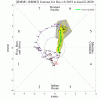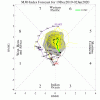Here are some basic definitions you can pull from the first link, I've added some of my own discussion in this first half of this post.
The global wind oscillation (GWO) took me a while to wrap my head around but the GWO at its core just atmospheric angular momentum & the tendency of atmospheric angular momentum, or the rate of change over time thus:
Global Wind Oscillation (GWO) = Atmospheric Angular Momentum (AAM) + Change in Atmospheric Angular Momentum per unit time (t).
The GWO thus encompasses phenomena like Convectively Coupled Kelvin Waves, the MJO, mountain & frictional torques, & even the El Nino Southern Oscillation to some extent. Why? Because all of these significantly impact AAM on timescales of several days to several weeks which is what we're mainly concerned about from a subseasonal standpoint.
Mountain & frictional torques operate on timescales of roughly several days to 2-3 weeks or so and are closely tied to variability in the extratropical storm track. A Rossby Wave (or mid-latitude cyclone or anticyclone) passing over major topographic features like the Rockies or Himalayas is what actually causes mountain torques. The resulting patterns from these mountain torques create Atmospheric Angular Momentum (AAM) anomalies and frictional torques then act to damp or weaken these anomalies.
This post goes very in depth on Atmospheric Angular Momentum & does a better job explaining than I personally would be able to:
https://www.netweather.tv/forum/top...ular-momentum/?do=findComment&comment=3907466
Angular momentum at its most basic level is a combination of the mass or weight of an object, how fast that object is rotating & the distance from its rotational axis.
I.e. Angular momentum = Mass + Rotational Speed + Distance (from axis of rotation).
Once you also consider that the earth system is relatively closed and therefore the total momentum of the earth system is just the summation of the solid earth angular momentum plus atmospheric angular momentum and must always be conserved
Total momentum = AAM + Momentum of Solid Earth
Change in momentum (M) over time (t) w/ change in time represented by "dt"
i.e. (M/dt) >>> AAM/dt + Earth Momentum/dt = 0
Hence, variations in one of these dictate the other. If AAM rises, as is often the case during El Nino events or West Pacific & Western Hemisphere MJO events or as we are going to see over the coming weeks, the earth's solid rotation will slow down in response (actually causes very minute changes to our length of day!) and frictional torques will act to try and weaken these AAM anomalies!
Torque: " "A turning force" that increases the angular momentum of the atmosphere creating a positive torque, one that decreases the angular momentum of the earth is a negative torque."
Mountain torque: "Mountain Torque is a function of pressure and orography and is the ‘turning force’ exerted due to a difference in pressure across any raised surface on the earth, but most significantly, mountains or mountain massifs. Consider a mountain with a high pressure on the west side of a mountain and low pressure on the east. The pressure system will exert an eastward torque that causes the earth to increase it’s rate of rotation, imparting angular momentum from the atmosphere to the solid earth. The opposite case, where there is higher pressure on the east side of the mountain, will slow the earth’s rotation down, reducing the solid earth’s angular momentum, and imparting it to the atmosphere. "
Frictional torque: "The friction torque is the torque that is exerted on the earth’s surface due to the frictional force that occurs because of the wind directly above the Earth’s surface moving relative to the solid earth. If there is an net global westerly surface wind (i.e. a surface wind from the west) the atmosphere will speed the earth’s rotation up, transfer angular momentum to the earth, and thus the atmosphere loses angular momentum. Analogously, if there is a net easterly surface wind (i.e. a surface wind from the east), the atmosphere slows down the rotation of the earth and angular momentum is transferred from the earth to the atmosphere"
Hope this post helps everyone.

















